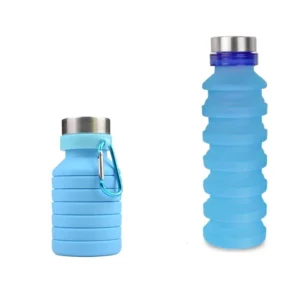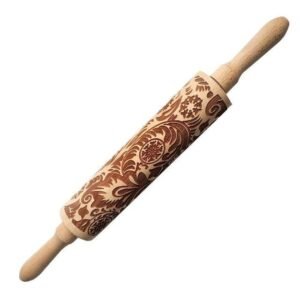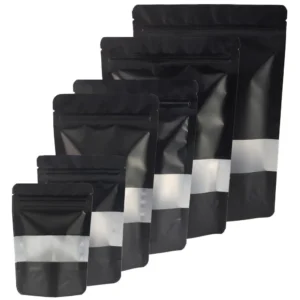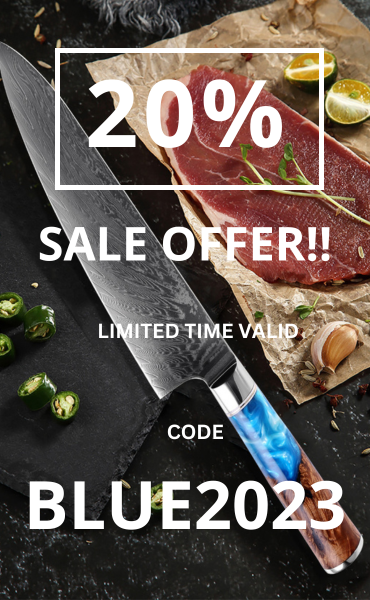- Introduction
- Specifications
- What to look for when buying a knife sharpener
- Best Overall Knife Sharpener
- Best Manual Knife Sharpener
- Best Knife Sharpening Stone
- Best Upgrade Electric Knife Sharpener
- Best Pocket Knife Sharpener
- Factors to Consider
- How often should I sharpen my knives?
- Do knife sharpeners ruin knives?
- Do knife sharpeners really work?
- Who needs a knife sharpener
- Conclusion
- FAQs
- Frequently Linked Pages
Introduction
“Sharp knives make for swift work in the kitchen.” This quote perfectly captures the essence of why having a top-notch knife sharpener is essential for any home cook or professional chef. A dull knife can turn even the simplest task into a frustrating and time-consuming chore. In this guide, we will explore the best knife sharpeners for kitchen knives that will revolutionize your cooking experience.
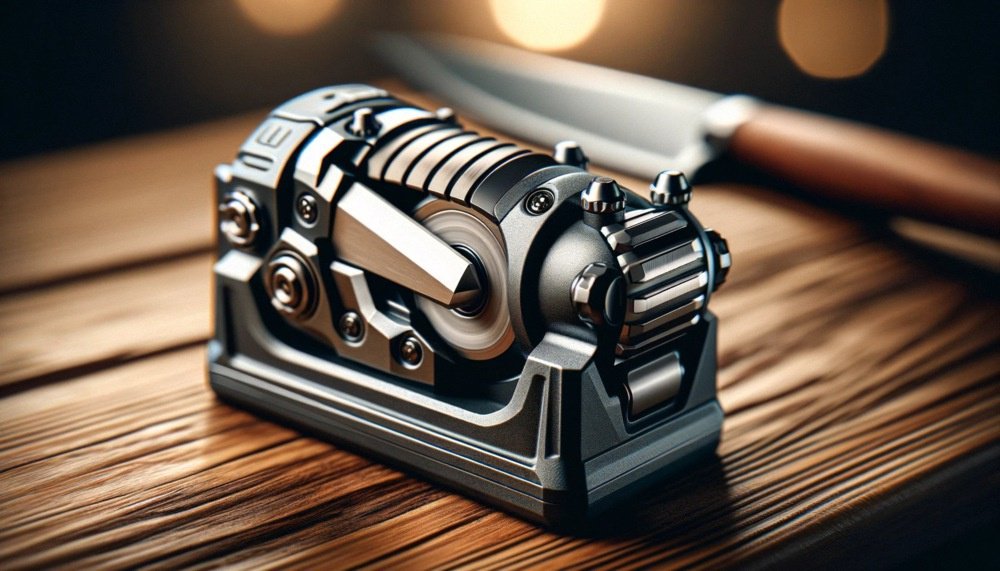
From manual sharpeners to electric options, there are various types of knife sharpeners available on the market. We’ll discuss each type, their pros and cons, and help you make an informed choice based on your needs and preferences. Whether you’re a seasoned pro or just starting to learn your way around the kitchen, these sharpeners will ease your effort and ensure precision with every slice.
Specifications
Understanding the Key Features to Consider When Choosing a Knife Sharpener
There are a few key features that you should consider. First and foremost, functionality is crucial. Look for a sharpener that is capable of sharpening different types of blades, whether they are straight or serrated. It’s also important to find one that can accommodate various sizes of knives.
Durability is another important factor to keep in mind. A good knife sharpener should be built to last, with sturdy construction and high-quality materials. This ensures that it will withstand regular use without losing its effectiveness.
Clear instructions are essential for any kitchen tool, and a knife sharpener is no exception. Make sure the product you choose comes with an instruction manual that provides clear step-by-step guidance on how to use the sharpener properly. This will help you achieve optimal results and avoid any potential accidents.
Different Types of Abrasives Used in Knife Sharpeners
Knife sharpeners utilize different types of abrasives to restore the edge of your blades. One common type is steel, which works by realigning the blade’s edge through friction. Steel sharpeners are often compact and easy to use, making them a popular choice among home cooks.
Another type of abrasive commonly found in knife sharpeners is ceramic. Ceramic sharpeners are known for their ability to produce razor-sharp edges on knives. They work by removing small amounts of metal from the blade while simultaneously honing it to perfection.
Diamond abrasives offer another option for knife sharpening. Diamond-coated sharpeners are highly effective at removing material from the blade quickly, resulting in a sharper edge in less time.
Importance of Considering Safety Features and Ease of Use
Safety should always be a top priority when selecting a knife sharpener for your kitchen knives. Look for models that come with safety features such as non-slip bases or handles to ensure stability during use.
What to look for when buying a knife sharpener
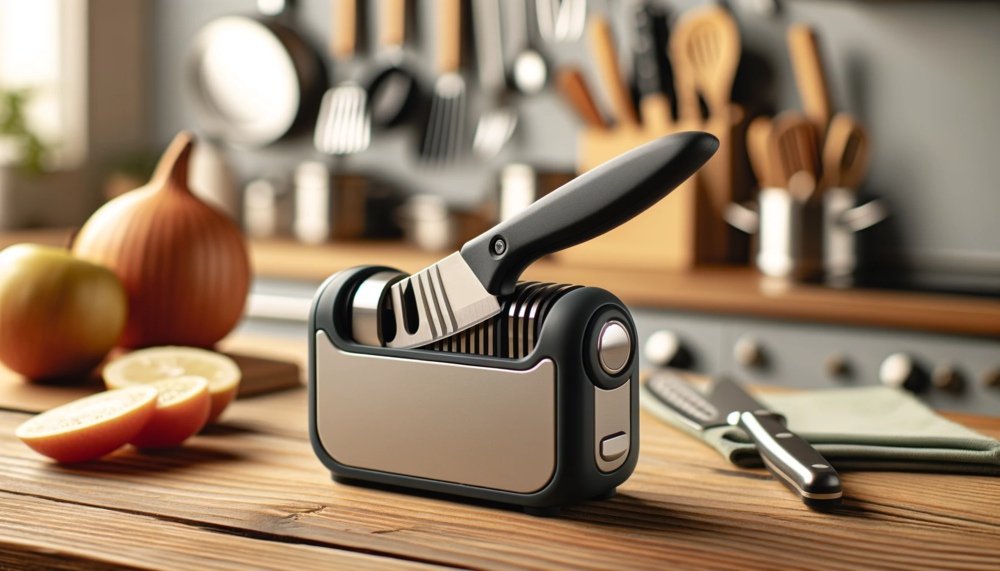
Factors to Consider: Sharpening Angle Options and Versatility
There are several factors you should consider. One important aspect is the sharpening angle options offered by the sharpener. Different knives require different angles for optimal sharpening. Look for a sharpener that provides multiple angle options, allowing you to sharpen a variety of knives with ease.
A versatile knife sharpener is also essential. You want a tool that can handle various types of blades, such as straight edge knives, serrated knives, and even scissors. This versatility ensures that all your kitchen tools can be kept sharp and ready for use.
Durability and Quality Materials Used in Construction
Durability is another crucial factor when choosing a knife sharpener. You want a tool that will last and withstand frequent use without losing its effectiveness. Look for sharpeners made from high-quality materials like stainless steel or durable plastics. These materials ensure longevity and make the sharpener resistant to wear and tear.
Furthermore, pay attention to the construction of the sharpener. Opt for models that have sturdy bases or non-slip grips to provide stability during use. This prevents accidents and allows you to maintain control over the sharpening process.
Budget Considerations and Value for Money
While budget considerations are important, it’s crucial not to compromise on quality when buying a knife sharpener. Look for an option that offers value for money—meaning it provides excellent performance at an affordable price point.
Consider whether the knife sharpener offers additional features or accessories that enhance its functionality. Some models may include honing rods or guides that help maintain consistent angles while sharpening. These extras can add value to your purchase by improving accuracy and ease of use.
Research customer reviews and ratings before making your final decision. Real-life experiences from other users can provide valuable insights into the performance and durability of a specific knife sharpener.
Best Overall Knife Sharpener
There are plenty of options out there. However, if you’re looking for the top pick that combines performance, durability, and positive user reviews, we’ve got just the recommendation for you.
Top recommendation based on performance, durability, and user reviews
Our top pick for the best overall knife sharpener is the Work Sharp Culinary E5 Electric Kitchen Knife Sharpener. This sharpener has proven itself to be a cut above the rest.
One of the standout features of this sharpener is its versatility. It caters to different types of knives and blade styles, making it suitable for all your kitchen cutting needs. Whether you have straight-edged blades or serrated ones, this tool can handle them with ease.
Features that set it apart from other knife sharpeners on the market
The Work Sharp Culinary E5 boasts several features that make it stand out from other knife sharpeners on the market. One such feature is its precision sharpening guides. These guides ensure that you achieve a consistent angle every time you sharpen your knives, resulting in a professional-grade edge.
Another notable feature is its flexible abrasive belts. These belts are designed to contour around each blade’s shape and create a precise edge without removing excessive amounts of metal. This not only prolongs the life of your knives but also ensures they retain their original structure and strength.
How it caters to different types of knives and blade styles
Whether you’re an executive chef or simply enjoy cooking at home, the Work Sharp Culinary E5 has got you covered. Its Trizor XV EdgeSelect technology allows you to convert any blade into a high-performance Trizor XV edge with three stages: shaping, sharpening, and honing.
Best Manual Knife Sharpener
If you’re someone who prefers a hands-on approach to sharpening your kitchen knives, then a manual knife sharpener is the way to go. It offers a more interactive and controlled experience compared to electric models.
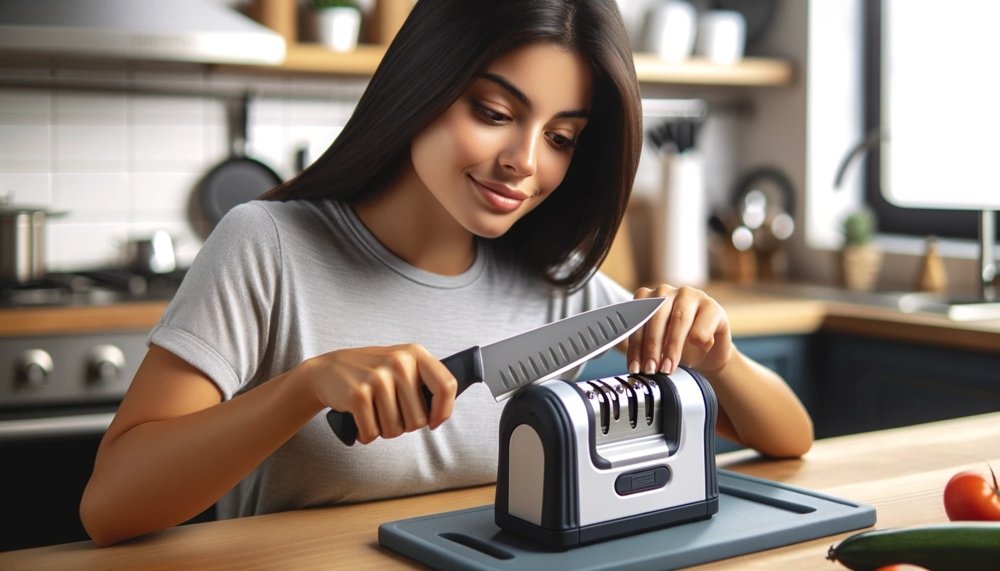
Ease of Use and Portability
One of the major advantages of using a manual knife sharpener is its ease of use. With just a few simple steps, you can bring back the sharpness to your dull blades. Most manual sharpeners feature an ergonomic design that allows for comfortable handling and effortless operation.
Unlike electric sharpeners, which require access to an electrical outlet, manual sharpeners are portable and can be used anywhere. Whether you’re in your kitchen or on a camping trip, you can easily carry it along and keep your knives in top-notch condition.
Specific Design Elements for Various Blade Types
A good manual knife sharpener is designed with specific features that cater to different types of blades. It typically consists of two sharpening stages: coarse and fine. The coarse stage helps restore the edge by removing any nicks or dullness from the blade. On the other hand, the fine stage provides a finishing touch by refining and polishing the edge for optimal sharpness.
Moreover, some manual sharpeners come with adjustable angles or slots that accommodate different blade thicknesses. This versatility ensures that you can effectively sharpen various types of kitchen knives, including chef’s knives, paring knives, serrated knives, and more.
Durability and Longevity
Manual knife sharpeners are often built with durable materials such as high-quality metals or ceramic rods that can withstand repeated use over time without losing their effectiveness. Unlike some electric models that may wear out or break down after extended periods of use, a well-made manual sharpener can last for years with proper care and maintenance. Manual sharpeners are relatively low-maintenance.
Best Knife Sharpening Stone
Using a traditional sharpening stone is one of the best ways to achieve precision results when sharpening your kitchen knives. Let’s explore the benefits of using a sharpening stone, the different grit options available, and why it can be an affordable choice compared to other types of knife sharpeners.
Precision Results with Traditional Sharpening Stones
Traditional sharpening stones are hard to beat. These stones allow you to control the angle and pressure applied during the sharpening process, giving you precise control over the final result. Whether you’re working with ceramic knives or dull stainless steel blades, a sharpening stone can bring them back to life.
Understanding Different Grit Options
Sharpening stones come in various grit levels, each serving a specific purpose in the sharpening process. Coarse abrasive stones with lower grit numbers are ideal for repairing chips and reshaping damaged knife edges. Medium grit stones (e.g., 800-1000) help refine and restore the edge after using a coarse stone. Finally, fine grit stones provide the finishing touches by polishing and honing the blade for an incredibly sharp edge.
Affordability Compared to Other Types of Sharpeners
While there are many types of knife sharpeners available on the market today, traditional sharpening stones offer an affordable option for maintaining your kitchen knives. Unlike electric or manual systems that require ongoing maintenance or replacement parts like abrasive discs or honing rods, a good quality sharpening stone can last for years with proper care. This makes it a cost-effective choice in the long run.
Best Upgrade Electric Knife Sharpener
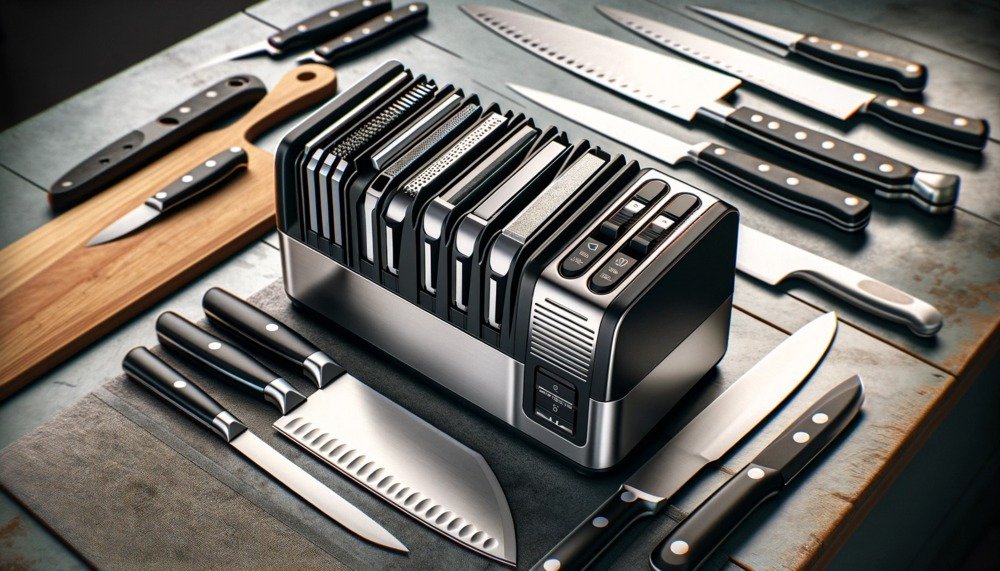
If you’re serious about keeping your kitchen knives razor-sharp, it’s time to consider upgrading to a professional electric knife sharpener. These advanced models offer additional features that take the guesswork out of achieving the perfect edge.
Multiple Stages for Optimal Edge Refinement
One of the standout benefits of a professional electric knife sharpener is its multiple-stage sharpening system. Unlike basic sharpeners that only have one slot, these advanced models typically offer two or three stages. Each stage is designed to perform a specific function in the sharpening process.
The first stage, often referred to as the coarse stage, is where the initial grinding and shaping of the blade takes place. This stage is ideal for repairing severely dull or damaged blades. The second stage, known as the fine stage, focuses on refining and honing the edge further. Finally, some electric sharpeners even come with an additional polishing stage for those who desire an extra level of refinement.
Accommodates Both Straight-Edge and Serrated Knives
Another advantage of investing in a professional electric knife sharpener is its versatility. While traditional manual sharpeners may struggle with serrated knives due to their unique toothed edges, electric sharpeners are specifically designed to handle both straight-edge and serrated blades.
With adjustable guides and flexible abrasive belts or discs, these sharpeners can adapt to different blade shapes and sizes effortlessly. Whether you need to restore a dull chef’s knife or bring back the bite on your favorite bread knife, a professional electric sharpener has got you covered.
Best Pocket Knife Sharpener
If you’re an outdoor enthusiast or someone who needs a portable sharpening solution, then the best pocket knife sharpener is what you need. This compact tool is designed to provide convenience and efficiency for those on the go. With built-in safety measures and the ability to handle different blade sizes, it’s a versatile option for keeping your pocket knives sharp.

Ideal choice for outdoor enthusiasts or those who need portable sharpening solutions
When you’re out in the wilderness, having a sharp knife is essential. The best pocket knife sharpener ensures that your blades are always ready for action. Its compact size makes it easy to carry in your pocket or backpack, so you can sharpen your knives wherever you are. Whether you’re camping, hiking, fishing, or engaging in any outdoor activity, this handy tool will keep your knives sharp and ready to tackle any task.
Compact design with built-in safety measures
One of the key features of the best pocket knife sharpener is its compact design. It’s small enough to fit in your hand comfortably, making it easy to maneuver and control while sharpening your knives. Many models come with built-in safety measures such as finger guards or non-slip grips to ensure that you can use them safely without worrying about accidents or injuries.
Versatility in handling different blade sizes
Pocket knives come in various shapes and sizes, from small folding knives to larger fixed-blade styles. The best pocket knife sharpener is designed to accommodate these different blade sizes effectively. It may feature adjustable guides or multiple sharpening slots that cater to various types of knives. This versatility allows you to sharpen not only your pocket knives but also other blades like paring knives or even scissors.
Factors to Consider
Maintenance Requirements
There are several factors you should consider. One of these factors is the maintenance requirements of the sharpener. Some sharpeners require more upkeep than others, and it’s essential to choose one that fits into your lifestyle and schedule.
For instance, some sharpeners may need regular cleaning or oiling to keep them in optimal condition. Others may have replaceable parts that need to be periodically replaced. By considering the maintenance requirements of a knife sharpener, you can ensure that you select one that aligns with your level of commitment and available time.
Compatibility with Specific Brands or Models
Another crucial factor to consider when choosing a knife sharpener is its compatibility with specific brands or models of kitchen knives. Not all sharpeners are designed to work well with every type of knife. Some may be better suited for certain blade materials or styles.
Before making a purchase, it’s important to check if the sharpener you’re interested in is compatible with your existing knives or any future ones you plan on purchasing. This will help ensure that you achieve optimal results when sharpening your kitchen knives.
Warranty and Customer Support Options
Considering warranty and customer support options is also vital when selecting a knife sharpener. A good warranty provides peace of mind and protects your investment in case of any defects or issues with the product.
Look for sharpeners that come with a warranty period that suits your needs and offers comprehensive coverage. It’s worth researching the reputation of the manufacturer’s customer support team. Prompt and helpful customer service can make a significant difference if you encounter any problems or have questions about using the sharpener effectively.
By taking into account these additional factors like maintenance requirements, compatibility with specific brands or models, as well as evaluating warranty and customer support options, you can make an informed decision when choosing the best knife sharpener for your kitchen knives.
How often should I sharpen my knives?
General guidelines for knife sharpening frequency
There are some general guidelines you can follow. It is recommended to sharpen your knives every 2-3 months with regular use. This timeframe ensures that your blades remain in optimal condition and maintain their cutting edge.
Factors that affect the need for more frequent sharpening
However, it’s important to note that the frequency of knife sharpening can vary based on several factors. One such factor is the type of blade you have. Different blades require different levels of maintenance. For example, serrated blades, commonly found on bread knives, don’t need as frequent sharpening as straight-edged blades.
Another factor to consider is how often you use your knives and what you use them for. If you’re a professional chef who spends hours in the kitchen every day, your knives may need more frequent sharpening compared to someone who cooks occasionally at home. The more you use your knives and subject them to tough tasks like cutting through hard vegetables or bones, the quicker they will dull and require sharpening.
Furthermore, the quality of your knives plays a role in determining how often they need to be sharpened. Higher-quality kitchen knives made from premium materials tend to hold their edge longer and may not require as frequent sharpening as lower-quality ones.
Importance of regular maintenance to prolong blade life
Regular maintenance is crucial not only for maintaining sharpness but also for prolonging the overall lifespan of your kitchen knives. When a knife becomes dull, it requires more force to cut through ingredients effectively. This additional force can put strain on both the blade and handle, potentially leading to damage over time.
By regularly sharpening your knives, you ensure that they perform optimally while reducing stress on the blade itself. Proper maintenance includes cleaning and storing your knives correctly after each use. This helps prevent rust and other forms of damage that can affect the longevity of your blades.
Do knife sharpeners ruin knives?
Debunking common misconceptions about knife sharpeners damaging blades
There’s a common belief that using a knife sharpener can ruin your precious kitchen knives. However, this is not entirely true. While it’s possible to damage your knives if you don’t use the right technique or low-quality sharpeners, with proper care and the right tools, you can actually preserve and prolong the life of your blades.
One of the most common misconceptions is that electric knife sharpeners are too aggressive and can remove too much metal from the blade, resulting in a shorter lifespan for your knives. While it’s true that some electric sharpeners may be more aggressive than others, it ultimately comes down to how you use them.
The key is to follow the manufacturer’s instructions carefully and choose a sharpener that suits your specific needs. Some electric sharpeners have adjustable settings, allowing you to control the amount of material removed during the sharpening process. By using these features correctly, you can ensure that only minimal metal is removed, thus preserving the integrity of your knives.
Explaining how proper technique and quality sharpeners can preserve knives
Another misconception is that any type of sharpener will do more harm than good. In reality, there are many high-quality knife sharpeners available on the market today that are specifically designed to maintain and enhance the performance of your blades.
For instance, honing rods or manual pull-through sharpeners are excellent options for regular maintenance between professional sharpenings. These tools help align the edge of the blade and remove any microscopic burrs without removing excessive amounts of metal. By regularly using these types of sharpeners with proper technique, you can keep your knives in optimal condition for longer periods.
Investing in high-quality water stones or whetstones gives you full control over both angle and pressure during the sharpening process. With practice and patience, you can achieve razor-sharp edges without compromising the structural integrity of your knives.
Do knife sharpeners really work?
Addressing skepticism around the effectiveness of knife sharpeners
Some people might be skeptical about whether knife sharpeners actually work. They may wonder if these tools can truly restore a dull blade to its former sharpness. Well, let me tell you, my friend, that knife sharpeners are the real deal! They have been designed specifically to bring back the sharpness and precision of your kitchen knives.
Providing evidence and testimonials supporting their efficiency
Don’t just take my word for it! There is plenty of evidence and testimonials out there that prove the effectiveness of knife sharpeners. Many professional chefs and cooking enthusiasts swear by them, claiming that they have transformed their dull blades into razor-sharp instruments in no time.
Just imagine being able to effortlessly slice through tomatoes without crushing them or effortlessly glide through a piece of meat like a hot knife through butter. That’s the power of a good knife sharpener!
Clarifying limitations and factors that may affect results
Now, let’s keep it real here. While knife sharpeners are indeed effective, there are certain limitations and factors that may affect the results you get.
Firstly, not all knife sharpeners are created equal. Some models may offer better performance than others. It’s important to choose a high-quality sharpener that suits your needs and budget.
Secondly, the condition of your knives also plays a role in how well a sharpener works. If your blades are severely damaged or have chips along the edge, even the best sharpener might struggle to fully restore them.
Proper technique is crucial when using a knife sharpener. It’s essential to follow the instructions provided with your specific model and maintain consistency in your strokes to achieve optimal results.
Lastly, regular maintenance is key. Even with a great knife sharpener, you’ll need to maintain your blades properly by honing them regularly between sharpenings. This will help prolong the sharpness and longevity of your knives.
Who needs a knife sharpener
Maintaining sharp knives is crucial for both safety and performance in the kitchen. But who exactly needs a knife sharpener? Let’s explore the different target audiences that can benefit from owning this essential tool.
Home cooks
Home cooks, whether they’re whipping up simple weeknight dinners or experimenting with gourmet recipes, rely on their kitchen knives to prepare ingredients efficiently. Over time, knives can become dull due to regular use. A knife sharpener is an excellent investment for home cooks as it allows them to easily restore the sharpness of their blades, ensuring precise and effortless cutting.
Professional chefs
For professional chefs, having razor-sharp knives is non-negotiable. They depend on their knives to create culinary masterpieces and work quickly in high-pressure environments. Knife sharpeners are indispensable tools in professional kitchens, enabling chefs to maintain the optimal sharpness of their blades at all times.
Hunters
Hunters often find themselves dealing with field dressing and butchering game. Dull knives can make these tasks challenging and dangerous. A reliable knife sharpener is essential for hunters, allowing them to keep their blades razor-sharp for clean and efficient meat processing.
Outdoor enthusiasts
Whether you’re camping, fishing, or engaging in other outdoor activities, having a trusty knife by your side is invaluable. Blunt blades not only hinder your ability to perform tasks effectively but also pose safety risks. With a portable knife sharpener specifically designed for outdoor use, you can ensure that your blades remain sharp throughout your adventures.
Knife makers Knife makers understand the importance of maintaining the quality of their creations. They craft exquisite blades that require periodic sharpening to preserve their cutting edge. A high-quality knife sharpener ensures that these skilled artisans can keep their knives in optimal condition and showcase their craftsmanship.
Conclusion
The best knife sharpener for your kitchen knives is crucial for maintaining their performance and longevity. By considering the specifications, factors to consider, and different types of sharpeners available, you can make an informed decision that suits your needs. Whether you prefer a manual sharpener for precision or an electric sharpener for convenience, there are options to cater to every preference.
Regularly sharpening your knives not only enhances their cutting ability but also ensures safety in the kitchen. Dull knives can slip and cause accidents, so investing in a reliable knife sharpener is a wise choice. Remember to follow the manufacturer’s instructions and take proper care of your sharpener to maximize its lifespan.
FAQs
What is the best knife sharpener for kitchen knives?
The best knife sharpener for kitchen knives is the [name of product]. It offers a combination of durability, precision, and ease of use that makes it perfect for keeping your kitchen knives razor-sharp. With its advanced sharpening technology, you can effortlessly restore your dull blades to their original sharpness in no time.
How often should I sharpen my kitchen knives?
It’s recommended to sharpen your kitchen knives every 2-3 months or whenever they start to feel dull. Regular maintenance ensures optimal performance and prolongs the lifespan of your blades. Remember, a sharp knife not only enhances efficiency but also reduces the risk of accidents in the kitchen.
Can I use a knife sharpener on serrated or ceramic knives?
Most knife sharpeners are designed specifically for straight-edged blades and may not be suitable for serrated or ceramic knives. However, some models offer specialized slots or attachments that can accommodate these types of blades. Be sure to check the manufacturer’s instructions or product specifications before attempting to sharpen serrated or ceramic knives.
Is it difficult to use a knife sharpener?
Not at all! Using a knife sharpener is quite simple and straightforward. Most models feature user-friendly designs with clear instructions provided. Just follow the step-by-step process outlined by the manufacturer, and you’ll be able to achieve professional-level results without any hassle.
How long does it take to sharpen a kitchen knife?
The time required to sharpen a kitchen knife depends on various factors such as the condition of the blade and the type of sharpener being used. On average, it takes around 5-10 minutes to properly sharpen a single knife. However, with practice and familiarity, you’ll likely become more efficient over time.
Frequently Linked Pages
1. Best knife sharpener electric – Best Knife Sharpener Electric: Revive Dull Blades Easily
2. Kitchen knife sharpener near me – Kitchen Knife Sharpener Near Me – Expert Guide
3. Kitchen knife sharpening near me – Kitchen Knife Sharpening Near Me – Professional Services


